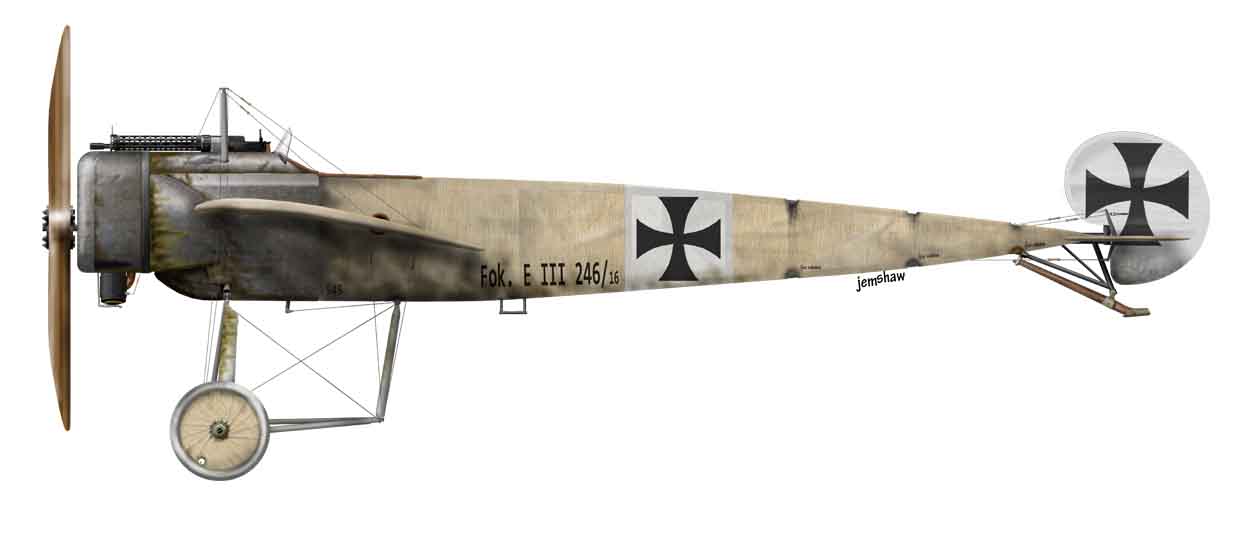| | | The Larks | | | All This Way for a Shilling | | | Yellow Impi | | | Back Burner | | | Other Nonsense | | | About Me |



Fokker E.III (1915)
The Fokker Scourge
The light, fragile Fokker E.III Eindecker was the first machine to be delivered in numbers to the Western Front. Its predecessor, the E.II, had already carved out a deadly reputation, but its small numbers prevented it making much other than reputational impact until the arrival of the E.III. It wasn't particularly fast, and its manouevrability was compromised by Anthony Fokker's decision to use wing-warping rather than the more modern ailerons to control roll. Yet it was responsible for the Fokker Scourge that wrought so much devastation on allied air forces between 1915 and 1916.
So what made it so dangerous? Germany had perfected an interruptor gear that allowed the gun to fire through the arc of the airscrew. It prevented the gun from firing as a blade was passing in front of it. As a result, aiming the gun simply entailed aiming the aircraft. Allied attempts to design a similar system proved unreliable and various alternative approaches were attempted. In some cases, a gun was mounted on the side of the fuselage, angled outwards and extremely difficult to aim. Some were mounted on the top wing to fire over the airscrew, but these were inaccurate and difficult to reload or clear jams. Pusher configurations like the Vickers Gunbus, FE.2 and Airco DH-2 bridged the gap until the introduction of the dependable Constantinescu interruptor.
The E.III saw the emergence of the first great German aces, led by Oswald Boelcke, who scored nineteen of his forty kills in an Eindecker. Close behind him was Max Immelmann - he of the Immelmann turn - who downed fifteen allied planes on the type. Immelmann died on June 18, 1916 when his E.III was shot down by the F.E.2b of Lt. G.R. McCubbin and Corporal J.H. Waller.
General |
|
| Country of origin: | Germany |
| Crew: | 1 |
| Purpose: | Fighter |
| Powerplant: | 1 × Oberursel U.I 9-cyl. rotary engine, 75 kW (100 hp) |
| Armament: | 1 × 7.92 mm (0.312 in) LMG 08/15 machine gun |
Performance |
|
| Maximum speed: | 140 km/h (87mph) |
| Maximum ceiling: | 3,600m (11,810 ft) |
| Range: | 260km (164 miles) (est) |
Dimensions |
|
| Wingspan: | 9.52 m (31 ft 3 in) |
| Length: | 7.2 m (23 ft 7in) |
| Height: | 2.4 m (7 ft 10 in) |
| Weight: | 399kg (880lb) |
Figures from Wikipedia
My Picture
I have mixed feelings about this illustration. On the plus side, I'm pleased with the linen texture and the gun. both took many hours to get right. I also spent far too long on the circle-brushed cowlings, and then hid the effect almost completely with oil staining. The negatives concern - as always - insufficient oil staining on the fabric. It's a balance between seeing detail and covering everything with oil, and I still can't get it right. I could also be happier with the routing of the flying wires.
There should be text on the lower cutouts in the fuselage fabric, but I can't find what it says. I'm pretty sure the first word is "Hier" and the second word might begin with "an". I'm guessing at "Hier anheben" for "Lift here", but it could be an instruction not to! If anyone knows or has photographs, please get in touch. I'd be most grateful for your help.
Pages
Copyright © 2016-2024, Jem Shaw

